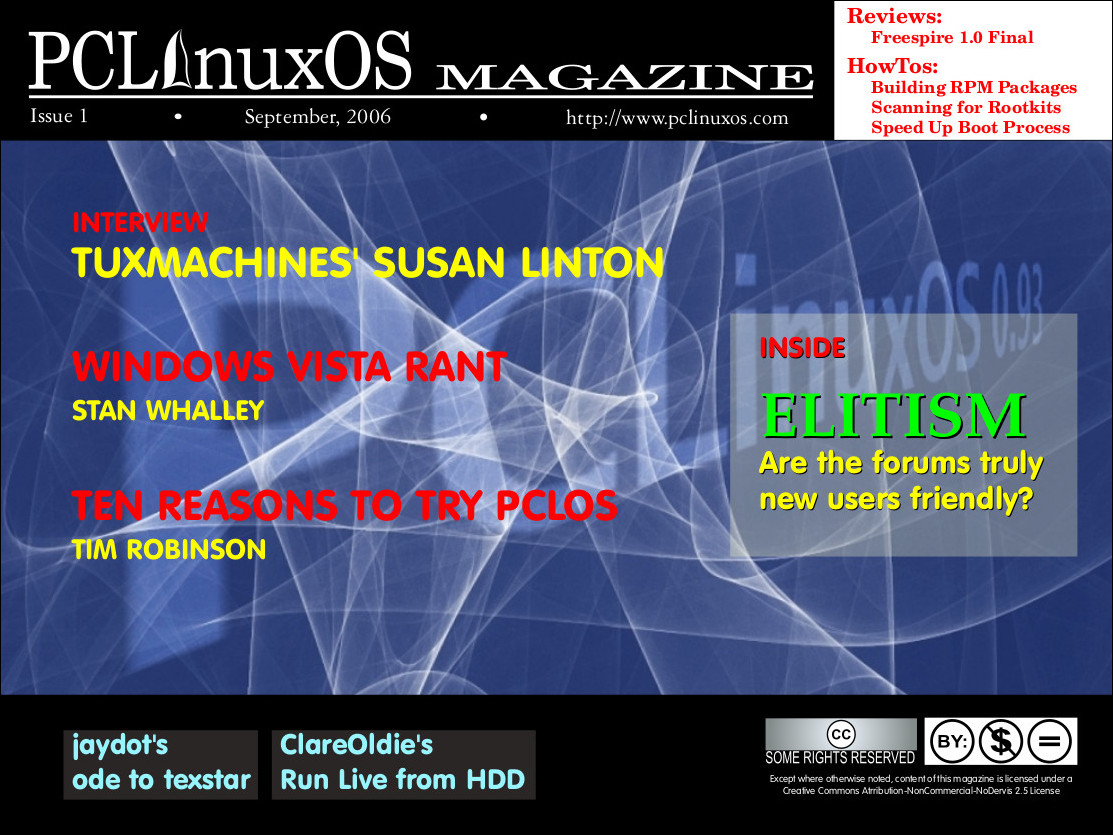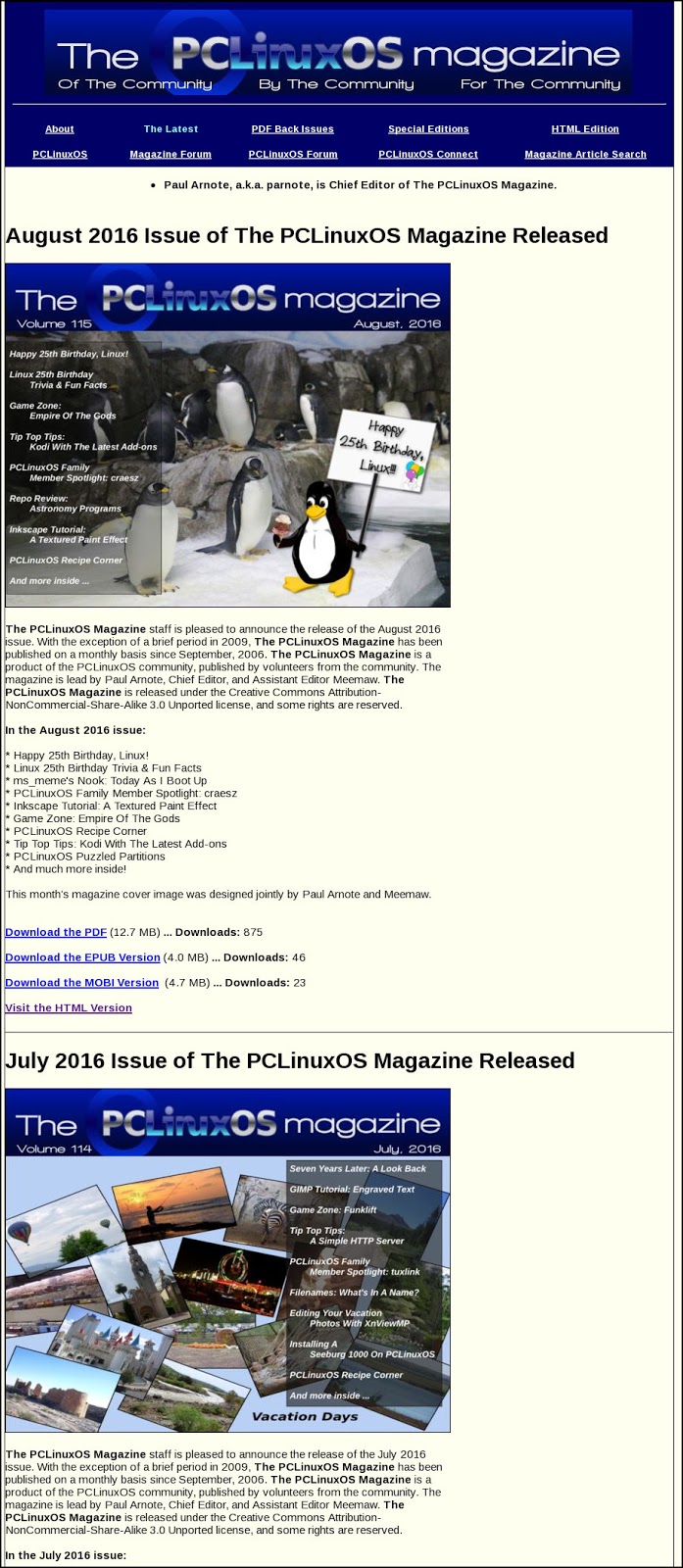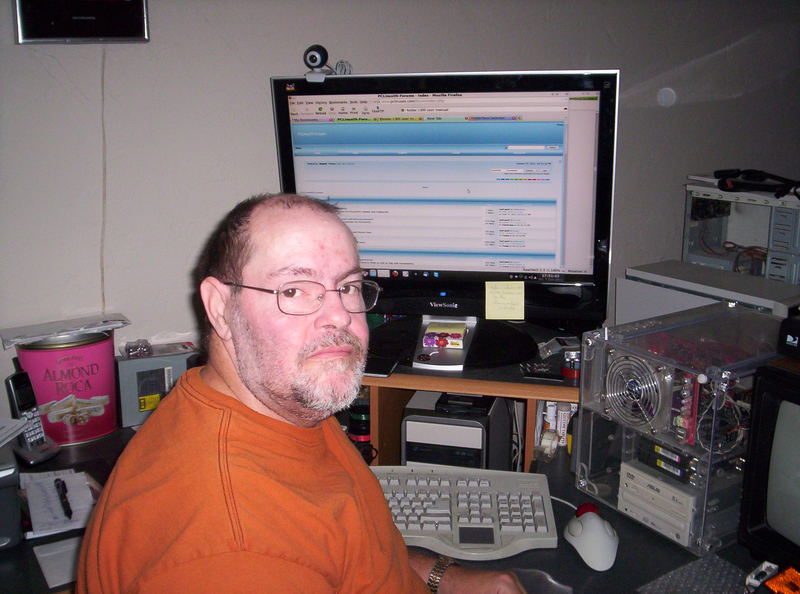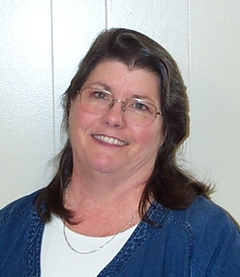| Previous
Page |
PCLinuxOS
Magazine |
PCLinuxOS |
Article List |
Disclaimer |
Next Page |
PCLinuxOS Magazine: 10 Years |
|
by Paul Arnote (parnote) It all started 10 years ago for The PCLinuxOS Magazine. It went like this, with an August 30, 2006 announcement on the old MyPCLinuxOS.com projects website. PCLinuxOS Magazine September 2006 Initial Issue
It is my privilege to announce on behalf of the team members of the PCLinuxOS Magazine Project sponsored by MyPCLinuxOS.com, the September 2006 introductory issue is available for download! We've put a lot of effort into producing a quality magazine made for the community, by the community.
Please note that the magazine is released under the Creative Commons Attribution-NonCommercial-NoDerivs 2.5 license unless otherwise stated on the articles themselves. By downloading this magazine you must acknowledge and accept this license agreement. We've released the magazine in two versions in pdf format. We designed the magazine for viewing in KPDF but other viewers will work as well. The two formats of the magazine are Viewer Default (VD) and Presentation Mode (PM). Viewer default will display the magazine in the default mode your reader is setup with and Presentation Mode starts in full screen. PCLinuxOS Editor-In-Chief, Archie, has further explanation of the downloads: "The following files are best viewed in KPDF. Other readers, such as Adobe Reader, Ghostview, XPDF can also be used. The following instruction is based on using KPDF. PCLinuxOS_Mag_200609_PM.pdf is initially in presentation. Moving pages forward is as easy as clicking the left mouse button. To go back a page, the user just right-click the mouse button. And exiting the Presentation Mode is not harder than pressing the ESC key. A user can also hover the mouse cursor on the top of the screen and there will appear some navigation buttons. On the top left-hand side are the blue forward and back buttons; on the right-hand side is the exit button."
Head over to the downloads section to download the latest issue of the magazine. Thanks for your interest in PCLinuxOS! If you feel you'd like to contribute to future issues, please check out the contribute link in the main menu. You can also drop us a line via the contact link in the main menu. If you have any suggestions, comments, or letters to the editor feel free to submit them this way or send an email to mag@mypclinuxos.com. Thanks and enjoy!
This announcement is all that remains of the discussions surrounding the first edition of The PCLinuxOS Magazine, and we only have that, thanks to the Internet Archive's Wayback Machine. The rest of it has been long lost in the great digital ethernet, including (unfortunately) the discussions that lead up to the magazine's creation. Most likely, those discussions fell victim to numerous forum software changes on the MyPCLinuxOS.com project site. Only the memories and reminiscing of the individuals involved remain, and most of those individuals have scattered to the wind as they went about their way and moved on from PCLinuxOS. There are only a handful of individuals remaining from the time of the magazine's first issue, namely Texstar, Not_Yet_16, jaydot, Archie and Neal ManBear.  Of those who remain, Not_Yet_16 (then known as ClareOldie) remembered the magazine's beginnings like this:
The thing I most remember about the process is the emphasis on quality that was engendered from the very beginning.
In those days, the articles were submitted in OpenOffice *.odt format. Today, the magazine articles are all in Google Docs. Even articles that are submitted to the magazine in .odt format are placed into Google Docs. This allows for collaborative editing by the magazine staff. Sometimes, even multiple magazine staff members are editing the same article at the same time. This not only facilitates openness and transparency, but it is a lot more efficient than emailing files back and forth -- and hoping you have the most recent version. The use of Google Docs dramatically streamlines this whole process. Today, "we" (The PCLinuxOS Magazine) will accept article submissions in any format you want to submit it in. Aside from Google Docs, we'll accept articles in LibreOffice *.odt format, AbiWord, in a *.tar.gz file that contains an annotated text file and pictures, or on paper napkins with stick figure drawings. All of them will be transferred to Google Docs by the magazine staff to facilitate the collaborative editing environment that we have all become accustomed to on today's magazine staff.The changing of the "guard" Archie served as the magazine's first Chief Editor, as well as the Chief Editor for the magazine's relaunch in July 2009. (Be sure to check out Archie's companion article in this issue, remembering how the magazine first came about.) The reins were then handed over to Tim Robinson. When Tim's health started to give him issues, he handed over the reins to a very capable John Paxton, a.k.a. Papawoob. Like his predecessor, Papawoob also encountered some health issues after about a year, so the Chief Editor position was handed over to Doug Wilson, a.k.a. historyb.  Previous editors, from left: Archie, Tim Robinson, Papawoob, historyb. Editor's note: Attempts were made, unsuccessfully, to contact Tim Robinson and Papawoob for this article. Our emails were not returned, so their whereabouts and welfare are not known. No attempts were made to contact historyb, for reasons you'll come to understand below. Also, the information immediately below isn't presented to reopen old wounds. Rather, it is a part of the history of PCLinuxOS and The PCLinuxOS Magazine. As such, it deserves coverage and remembering just as much as the successes of PCLinuxOS and The PCLinuxOS Magazine. After all, those who don't learn from history are bound to repeat it. For the first few issues, things went reasonably well for the magazine under historyb's leadership. But then the monthly deadlines and release schedules were beginning to be missed. So, historyb took it upon himself to change the magazine's publication schedule to quarterly. He covered it by claiming that there simply wasn't enough to talk or write about. The general consensus at the time was that one large quarterly magazine was better than no magazine at all, so the community more or less went along with the quarterly release schedule. That lasted for one quarterly issue before the second quarterly issue missed its scheduled release date. A couple more months (past the scheduled second quarterly release) went by before the PCLinuxOS community saw another release of the magazine released. That "special issue" was done primarily because enough articles had been submitted and amassed to warrant the publication of another issue. Around the same time, there was a bit of turmoil among those who were given the task of safeguarding and maintaining PCLinuxOS, since Texstar had taken a sabbatical for health reasons. A "messy" February 2009 release, coupled with some questionable "behind the scenes" antics prompted Texstar to return early from his health sabbatical to take the lead in righting the ship. Things were said, feelings got hurt, and a group of packagers left to create their own distro, which they called "Unity Linux" (which never really saw any significant success for a number of reasons). A "mutiny" of sorts ensued, and some regular users decided to follow the packagers who left to form Unity Linux. When the "special issue" of the magazine came out, the predominate (and often repeating) ad in that issue was for TinyMe, a stripped down, very small version of PCLinuxOS. Except, TinyMe was no longer an official PCLinuxOS release, especially since its maintainer was one of those who left for Unity Linux. When asked by Texstar to replace the ads, historyb refused. Instead, historyb tried to claim ownership of the magazine and attempted to kill the magazine off. Texstar ended up replacing the ads himself, and historyb fled to Unity Linux, as well. The initial discussions involving the release of the "special issue" and historyb's attempts to kill off the magazine were open and public in the PCLinuxOS forum. I happened to be on the forum that morning when the shiitake mushrooms hit the fan, and I remember the exchanges as if it were yesterday. After a while, those heated exchanges were moved to a more secluded section of the forum that wasn't in public view. As you might expect, the incident with historyb left Texstar "once bit, twice shy" in the trust department. For the next few years (yes, years) I would have to submit the monthly magazine to Texstar for his approval, before releasing it. Once we re-established trust with Texstar, that requirement was lifted and we could release on our own without prior approval. Since then, we have maintained not only a monthly magazine -- with over 14,000 packages in the repos, there is plenty to write about, if you just look hard enough -- but we have also put out several "special editions" of the magazine. Next in the evolving saga involved "negotiations" for the MyPCLinuxOS.com site, since the person who was hosting it -- and who owned the domain name -- was one of the Unity Linux defectors. The magazine also made its home on the MyPCLinuxOS server. Weric, who used to sell computers with PCLinuxOS already installed and configured through his company named LinPC.us, agreed to host the MyPCLinuxOS.com site, along with an expanded site for the magazine. (The site is still up, but does not appear to have been updated since sometime in 2015; thus, it's likely that the products listed can no longer be obtained or purchased). After a few years, Weric found himself in a position where he could no longer host MyPCLinuxOS.com, nor the magazine website. So, YouCanToo took over both domains and the hosting duties on his servers. The MyPCLinuxOS.com forum had already been shut down and discussions about development and special projects had already been moved to the main PCLinuxOS forum. The magazine's separate forum was shut down at this time, and discussions pertaining to the magazine were transferred exclusively to the main PCLinuxOS forum, as well.  The April 2012 move from Weric's server, where the magazine site used Joomla CMS software (we "inherited" it that way), gave us the opportunity to revamp the magazine's website. While we looked at WordPress to replace Joomla, the ultimate decision was made to forego the use of any CMS (content management system) software, opting instead for just plain HTML. Since updates only occurred to the magazine website once or twice a month, use of CMS software seemed like overkill. As the Chief Editor, one of my responsibilities is updating the website every month (except for the HTML version of the magazine issues, which YouCanToo lays out and takes care of uploading). I can attest that it involved a LOT more work to update the website under Joomla than as plain HTML. Plus, the website also loads a lot faster with plain HTML -- and especially without the overhead of CMS software. PDF, HTML and more From the start, the magazine has been published both as a downloadable PDF, and as HTML pages for online access. Under my tenure as Chief Editor, most of the PDFs have been created by me and Meemaw, using Scribus. In the very early days, former assistant editor Andrew Strick also helped with layout. Ms_meme lays out her own pages, which we insert into the PDF during final layout. The HTML pages have been under the oversight of four different individuals during my tenure. Initially, gseaman managed the HTML edition. When he was unable to continue doing the HTML pages (due to other commitments in his life), Sproggy took over. Rudge took over the HTML pages when Sproggy had to step back. Today, the HTML pages are managed and laid out by YouCanToo. We streamlined and simplified the HTML pages when we revamped the magazine website in April, 2012, enabling much faster layout. Faster layout helps us to better meet our release dates, so everyone wins. Starting in May 2012, YouCanToo has produced ebook versions of The PCLinuxOS Magazine. He produces both MOBI and EPUB ebook versions, enabling the magazine to serve the vast majority of ebook users, regardless of which platform they are using. Superman in our midst ... I was initially familiar with YouCanToo from the time I spent in the PCLinuxOS forum. What I didn't appreciate -- and didn't know -- at the time was the remarkable breadth of his knowledge, skills and capabilities.  YouCanToo Around PCLinuxOS, YouCanToo truly is our Superman. I'm going to try to give a rundown of the things that he does.
As you can see, YouCanToo does some real heavy lifting not only for PCLinuxOS, but also for The PCLinuxOS Magazine. Quite frankly, I don't know where any of this would be with him. I know I tell him "thank you" all the time, but it really doesn't seem sufficient. Like I said ... YouCanToo is OUR Superman. Many contributors I'd also like to take a moment to thank all of those who have contributed to The PCLinuxOS Magazine. Like with any Linux distro, people come and people go. Some move on to other adventures, others find a "home" and stay for a while, becoming a part of our PCLinuxOS "family." It's a very similar situation with The PCLinuxOS Magazine. Many, many contributors have helped shape the magazine. Some contribute one or two articles, while others have contributed to the magazine for years on a very regular basis.You probably know many of the names: ms_meme, georgetoon, daniel, Neal ManBear, jaydot, Not_Yet_16, loudog, critter, longtom, Hootiegibbon, Sproggy, cstrike77, Rudge, joechimp, YouCanToo, Archie, Rodney Adkins, and many, many others. Some are still with us, while others have moved on to other pastures. There are way too many to list here. Each and every contributor helps shape the magazine. Whether I listed your "name" or not, your contributions to the magazine are highly valued, and I thank each and every one of you.  Meemaw One special contributor is Meemaw, the magazine's assistant editor. Quite frankly, I doubt I'd be able to do this or even still be here in this position without her. Besides being a regular, monthly article contributor, she helps with the layout of the articles for the PDF, and does the final assembly of the magazine every other month. Add in helping proofread each and every article that appears in the magazine. Thank you, thank you, thank you a gazillion times for all that you do (and for putting up with me!). Summary The PCLinuxOS Magazine has always been produced as a magazine of the community, by the community, for the community. Of course, that community is PCLinuxOS. Quite simply, The PCLinuxOS Magazine belongs to YOU! We are only its caretakers, its stewards. At the same time, we strive to bring you a first rate, first class magazine that hits on topics that are of interest to PCLinuxOS users. The magazine is also an ambassador of sorts, introducing PCLinuxOS to those who don't use it or who aren't familiar with it. We are fully aware that non-PCLinuxOS users also read the magazine. I've heard and seen comments on other forums in Linux Land. None of us who work on the magazine get paid, at least in the traditional monetary sense. We all have paying jobs that put a roof over our heads and food on our tables. We all have families and other "life" responsibilities. Instead, for us, it's a labor of love, and it's one way we can give back to the PCLinuxOS community. A 10 year milestone is a huge accomplishment for any publication. It's an even bigger accomplishment for a completely free community based magazine, produced by volunteers from the community. As community projects go, most wither and die on the vine. People lose interest, move on to other projects, it turns out to be more work than they originally thought, etc. The PCLinuxOS Magazine is an exception to that, we feel. Because of that, it must go on. If there's something you want to see in the magazine, or a direction you want the magazine to go in, YOU must let us know. Or, you could join the magazine staff and help us attain those goals. Even better yet, you could write articles for the magazine (we can't possibly think of everything on our own). So, here's to looking forward to the next 10 years of The PCLinuxOS Magazine. The faces and names may change, but we will always strive to produce a magazine that the PCLinuxOS community can be proud of. |


